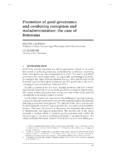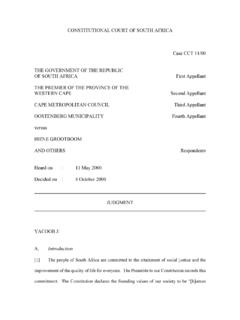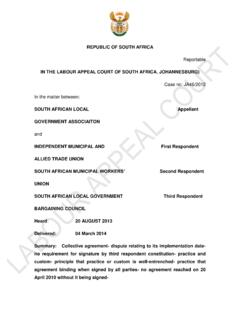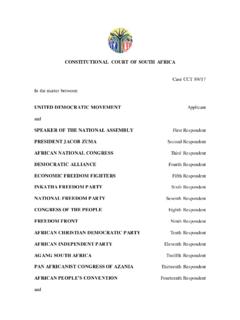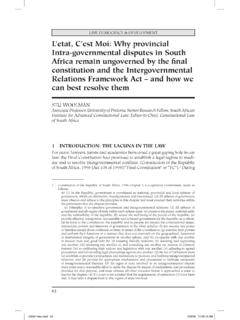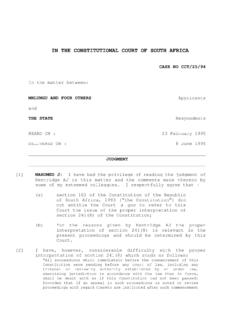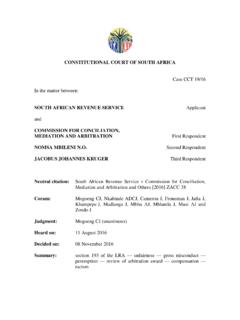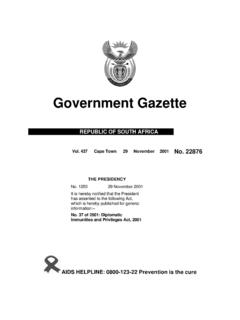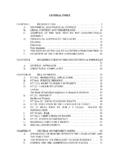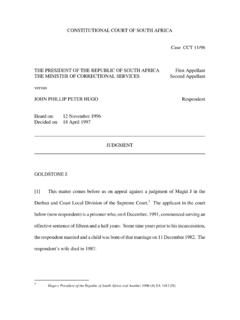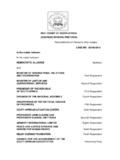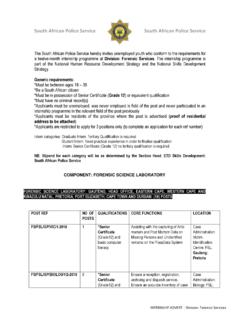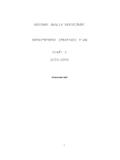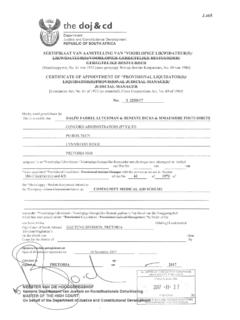Transcription of IN THE GAUTENG DIVISION HIGH COURT, …
1 1 IN THE GAUTENG DIVISION high court , pretoria ( republic OF SOUTH AFRICA) Case Number: 31971/2011 Coram: Molefe J Heard: 21 July 2014 Delivered: 11 September 2014 In the matter between: ALBERTUS J. RETIEF FIRST APPLICANT ULTIMATE SOFTWARE (CAPE TOWN) CC SECOND APPLICANT and J. P. KRIEL & CO RESPONDENT _____ JUDGMENT _____ MOLEFE, J: [1] This is an application for rescission of a default judgment granted by this court against the applicants (defendants in the main action) on 12 September 2013, on the ground that such order was granted in the absence of the applicants. The application is based on the provisions of Rule 31 (2) (b) alternatively Rule 42 (1) (a) alternatively the common law. The application is opposed by the respondent. The (1) REPORTABLE: YES / NO (2) OF INTEREST TO OTHER JUDGES: YES/NO (3) REVISED.. DATE SIGNATURE .. DATE SIGNATURE 2 respondent, prior to the hearing of the application condoned the applicants late filing of the Replying Affidavit.
2 [2] The requirements that an application for rescission in terms of rule 31 (2) (b) must satisfy are well established in Colyn v Tiger Food Industries Ltd t/a Meadow Feed Mills (Cape) 2003 (6) SA 1 (SCA) (2003) 2 ALL SA 113, at para 11 and other authority cited1. The applicant must show cause why the remedy should be granted. That entails (a) giving a reasonable explanation of the default; (b) showing that the application is made bona fide; and (c) showing that there is a bona fide defence to the plaintiff s claim which prima facie has some prospectus success. In addition, the application must be brought within 20 days after the defendant has obtained knowledge of the judgement . [3] In terms of Rule 42 (1) the court may, in addition to any other powers it may have mero motu or upon the application of any party affected, rescind or vary: an order or judgement erroneously sought or erroneously granted in the absence of any party affected thereby: an order or judgement in which there is an ambiguity or a patent error or omission, but only to the extent of such ambiguity, error or omission; an order or judgement granted as the result of a mistake common to the parties.
3 1 The court in Colyn concerned with an application for rescission in terms of Rule 42 (1) (a). This applicable approach is the same. 3 [4] For a rescission of an order in terms of the common law, sufficient cause must be shown, which means that: there must be a reasonable explanation for the default; the applicant must show that the application was made bona fide; and the applicant must show he has a bona fide defence which prima facie has some prospect of success. [5] In the current application, the application for rescission of judgement was made by the first applicant (first defendant in the main action) outside the twenty (20) day period prescribed in terms of rule 31 (2) (b). The applicants became aware of the judgement order on 9 October 2013 and the application for rescission was instituted on 8 November 2013.
4 Consequently, the applicants were required to show good cause why the period within which they could bring the rescission application should be extended. (See Uniform rule 27 (1) and (2). [6] It is appropriate to approach the application having regard to the requirements of rule 27 and rule 31 (2) (b) in an integrated manner. This entails the exercise by the court of a wide discretion upon consideration of all the relevant circumstances2. [7] The applicants reasons for the late filing of the rescission application were that having obtained knowledge of the order on 9 October 2013, the applicants launched an urgent application requesting the stay of the warrant of execution pending this application. On 31 October 2013, Honourable Raulinga J granted such 2 Silber v Ozen Wholesalers (Pty) Ltd 1954 (2) SA 354 (A) at 352 -3 4 relief and the applicants were afforded seven days to institute this application which the applicants did.)
5 It is the applicants submission that this rescission application has been launched within the time limits prescribed by the order granted on 31 October 2013. I am satisfied that the applicants have shown good cause why the periods within which to bring rescission application in terms of rule 31 (2) (b) should be extended. [8] The explanation given by the applicants for the default in filing a plea and being subsequently barred from doing so is that the applicants initially defended the action and also filed an exception to the particulars of claim. The exception was removed from the roll on 1 December 2011 and subsequent to the removal of the exception, but with the exception still pending, the applicants attorneys withdrew as their attorneys of record on 24 July 2012. The applicants endeavoured to appoint LIPO to act on their behalf but the court file could not be found as the case number referred to a different matter.
6 The applicants were under the impression that the respondent would communicate further proceedings to them and this was the reason why no further steps were taken. The first applicant submits that he was unaware of the default judgment application being enrolled on 12 September 2013, otherwise he would have acted to prevent such judgment being grated. [9] An order or judgment is erroneously granted in the absence of a party, if irrespective of whether or not such judgment order is otherwise correct, the absent party was not notified or did not know of the date of hearing. In my view, the applicants presented a reasonable and acceptable explanation for their failure to defend the action and are not in wilful default. It is also clear that the applicants were 5 not notified and did not know of the date of the default judgment application, therefore the judgment is erroneously granted in this respect.
7 [10] This matter deals with the respondent s claim for legal fees for professional services and expenses incurred for litigation instituted on behalf of the applicants by the respondent, an attorney. The first applicant submits that he gave instructions to the respondent in his capacity as a member of the second respondent. Respondent acted on behalf of the second applicant and the respondent s mandate was terminated on 16 September 2010. The first applicant contends that he did not personally undertake to pay any fees to the respondent on behalf of the second applicant. [11] Regarding the merits of this application, the applicants defences are that: an unenforceable contingency fees agreement was concluded between the second applicant and the respondent wherein the respondent would only take 25% share of the proceeds of litigation instituted; The respondent acted on behalf of the second applicant.
8 No agreement existed that the first applicant would be liable to pay any fees to the respondent for services rendered to the second applicant; a portion of the fees claimed had become prescribed. The respondent did not for a period of approximately 4 years render an account to the applicant; an account was only rendered when the respondents mandate was terminated; 6 the respondent s accounts are not taxed and the court cannot determine the reasonableness and the correctness thereof. [12] Applicant s counsel3 contends that the relationship between an attorney and client is based on an agreement of mandatum entitling the attorney, to payment of fees on performance of the mandate or the termination of the relationship. Counsel for the applicants relied on Benson & Another v Watters & Others4 wherein the court said: But what is clear is that by the end of the last century it had become an established practice that the court did not undertake the task of inter alia quantifying the reasonableness of attorneys fees and that taxation of such a bill of costs was left to the taxing officer.
9 This did not entail however, that an attorney could not sue or obtain judgement on an untaxed bill. Although .. the court assumed a discretion to order a bill to be taxed, and although a court would not allow an action to proceed if the client insisted on taxation, there was no reason why judgement could not be given for an attorney if the client was satisfied with the quantum of the bill but defended the action on some other ground . [13] Counsel for the applicants submits that a client is entitled to taxation of his or her attorney s account. It follows that the amount of a disputed bill of costs is not liquidated. In this regard, applicants counsel relied on Arie Kgosi v Kgosi Aaron Moshete & Others5, wherein Wessels JP said: 3 Advocate S J Myburgh 4 1984 (1) SA 73 (A) at 83 A - C 5 1921 TPD 524 at 526 7 An untaxed bill of costs is not an absolute and present debt, for it is one the exact amount of which is still to be ascertained, as it depends on the arbitrarium of the Taxing Master.
10 It cannot, therefore, be set off as against a liquidated debt . Mason J added in Arie Kgosi supra that: as soon as the client says I am not ready to pay, the attorney must have his bill taxed; and as soon as the question of taxation arises, the amount depends in nearly every instance on the discretion of the taxing master . [14] The applicants also rely on the judgement in Tredoux v Kellerman 2010 (1) SA 160 C, where the court held that: In any event there is authority for the proposition that an untaxed bill of costs does not constitute a liquidated amount of money-in at least in circumstances, as here, where the bill is being The learned Griesel J added: Even if I were to err in coming to this conclusion, and even if the plaintiff s claims were to be regarded as liquidated amounts, it has authoritatively been held that a party cannot recover his or her costs in the absence of prior agreement or taxation.
